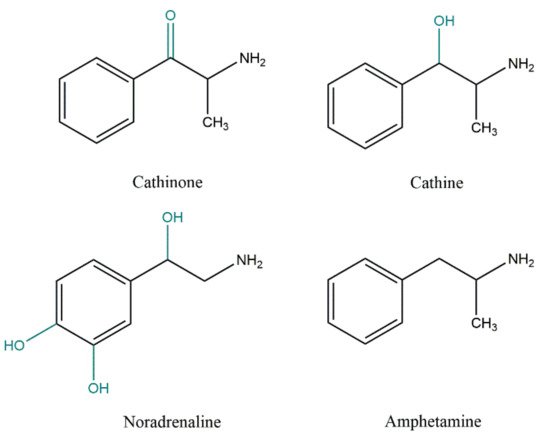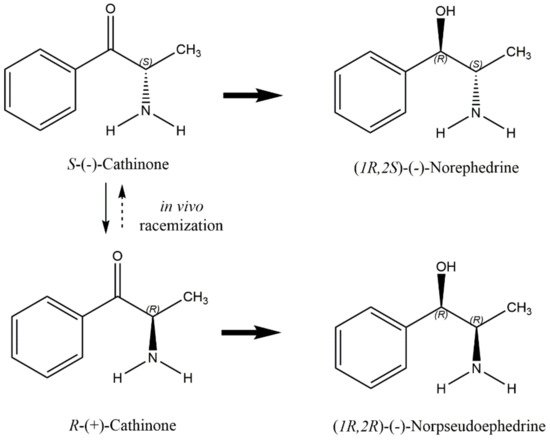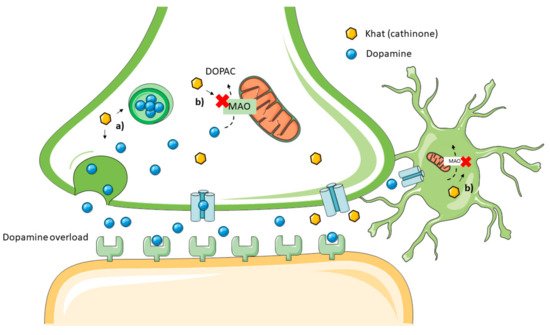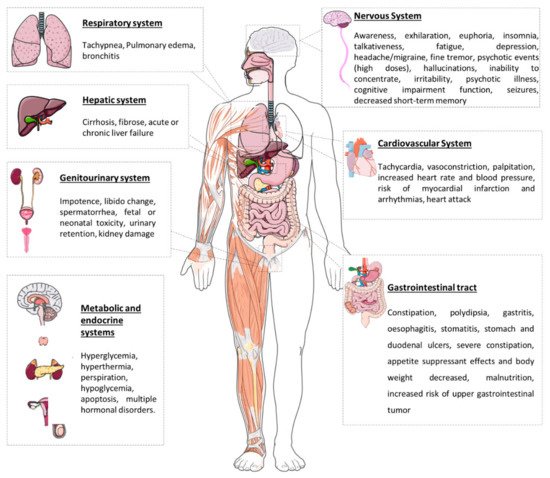Khat (Catha edulis) is a recreational, chewed herbal drug that has been used as a psychostimulant for centuries in East Africa and the Arabian Peninsula, namely in Somalia, Ethiopia, and Yemen. However, the growing worldwide availability of khat has produced widespread concern. The plant comprises a large number of active substances, among which cathinone, cathine, and norephedrine are the main constituents, which can be included in the group of sympathomimetics of natural origin. In fact, these compounds are amphetamine analogues, and, as such, they have amphetamine-like nervous system stimulant effects. Chewing the leaves gives people a sensation of well-being and increases energy, alertness, and self-confidence. The chronic use of khat is, however, associated with severe cardiac, neurological, psychological, and gastrointestinal complications. The psychological dependence and withdrawal symptoms of khat are the reasons for its prolonged use.
1. Introduction
Khat (
Catha edulis,
Celestraceae) is an evergreen shrub or tree (1–25 m tall), the fresh leaves of which contain cathinone, cathine, and norephedrine, which are sympathomimetic compounds. The plant is native to the Horn of Africa and the Arabian Peninsula and has been widely cultivated and consumed for centuries due to its psychostimulant effects [
1,
2]. Khat use for medical purposes is documented in the New Testament: the plant was considered as “divine food”, whereas Egyptians used it to achieve “apotheosis”—the feeling of transformation into a “god-like” stature.
Kitab al-Saidana fi al-Tibb is the oldest known (11th century) pharmaceutical and medical description of khat [
2]. In 1775, during a trip to Egypt and Yemen, botanist Peter Forskal identified the plant as
Catha edulis, a member of the family
Celastraceae. Other local names for
Catha edulis are qat, q’at, kat, kaht, gat, chat, tschat, mira, and murungu [
2,
3]. A famous Ethiopian folklore story tells that the first human user of this plant was a Yemeni shepherd, who noted the effects of khat on his goats. After the discovery of its effects, khat use became widespread between the occult, spiritual, and upper classes in Yemen in the 16th century. Afterward, in the beginning of the 19th century, its use turned out to be extraordinarily broad and practically universal in certain parts of Yemen [
4].
Fresh khat leaves are chewed by more than 20 million people across the Arabian Peninsula and East Africa every day, and this habit is deeply rooted in the socio-cultural traditions of these countries [
5].
2. Khat Phytochemistry
Wolfes found norpseudoephedrine (cathine) in the leaves of khat in 1930, and this alkaloid was considered to be the major active ingredient of khat until the 1960s. However, due to the statement of Brücke in 1941 that the amount of this alkaloid was not enough to account for the khat users’ symptoms, the chemistry of the plant was further studied, and cathinone was isolated for the first time [
8,
9]. In fact, cathinone is one of the most abundant alkaloids in fresh leaves of
Catha edulis, and the principal active constituent responsible for the stimulant effects of this ‘natural amphetamine’ [
11]. Nevertheless, cathinone is relatively unstable and decomposes into cathine and norephedrine after harvesting. This process is potentiated when the leaves are dried. Thus, only freshly picked leaves have full efficacy [
10,
12]. On average, fresh khat is reported to contain 36–343 mg of cathinone [
3,
13], but also 83–120 mg of cathine and 8–47 mg of norephedrine per 100 g of leaves [
13]. These compounds are structurally (
Figure 1) and pharmacologically similar to amphetamine and noradrenaline, showing their potential to affect the central and peripheral nervous systems [
14].
Figure 1. Chemical structures of cathinone, cathine (norpseudoephedrine), noradrenaline, norephedrine, and amphetamine. Structural differences to amphetamine are underlined (blue) in the other compounds.
Other phenylalkylamine alkaloids, such as phenylpentenylamines, merucathinone, pseudomerucathine, and merucathine, and also cathedulin alkaloids, are found in khat leaves, although their concentrations are relatively low [
15]. However, the chemical profiles of khat leaves are dependent on the environment, climate conditions, and cultivation and harvesting processes. Overall, fresh khat leaves comprise numerous distinct chemical substances, which include the following: alkaloids, terpenoids, glycosides, sterols, tannins, and flavonoids; several amino acids, such as tryptophan, glutamic acid, glycine, alanine, and threonine; vitamins, comprising ascorbic acid, thiamine, riboflavin, niacin, and carotene; elements, such as calcium, iron, manganese, copper, and zinc; and toxic metals, such as lead and cadmium [
15,
16,
17].
3. Khat Toxicokinetics
Khat is typically chewed, sporadically infused as a tea, and rarely smoked [
15]. Approximately 100–500 g of khat leaves are chewed in a single khat session over several hours. When chewed, the leaves are detached from their branches and kept in the mouth (chewed sporadically to discharge the active principles, or kept in the oral cavity) and later expectorated [
5,
18]. Approximately 90% of the alkaloids are effectively extracted from the leaves into the saliva by chewing [
19].
Following khat chewing, the psychostimulant effects appear 30 min later and last for 3 h [
3]. The oral mucosa performs a major role in the absorption of compounds from khat (60% of total absorbed. After swallowing, further absorption occurs in the stomach and small intestine [
15,
19,
20]. The maximum plasma concentration of cathinone is dependent on the dose ingested and is achieved within 1.5–3.5 h.
Cathinone undergoes phase I metabolism, catalysed by liver microsomal enzymes, namely via reduction of the β-keto group to an alcohol, producing cathine and norephedrine (
Figure 2) [
24,
25]. Cytochrome P450 2D6 (CYP2D6) seems to be involved in the conversion of cathinone to cathine [
26]. The metabolism is stereoselective: the major metabolite of
S-(−)-cathinone is norephedrine (
R,
S-(-)-Norephedrine), whereas the major metabolite of
R-(+)-cathinone is cathine (
R,
R-(-)-Norpseudoephedrine). Overall, almost all the cathinone is quickly and stereoselectively metabolized, and only a small amount, lower than 7%, is excreted unchanged in the urine [
24,
25].
Figure 2. Stereoselective cathinone metabolism and the main metabolites excreted in urine (adapted from [
24,
25]).
4. Khat Toxicodynamic
Cathinone and cathine are responsible for the main psychoactive and sympathomimetic effects of khat. Although both of them can stimulate the central nervous system (CNS), cathinone is mainly responsible for all the initial CNS actions of khat. Cathinone is a β-keto analogue of amphetamine (
Figure 1), and,
per se, it has amphetamine-like CNS stimulant effects [
16,
27,
28]. Amphetamine derivatives belong to the class of drugs called the ‘β-phenylethylamines’, and they are structurally similar to catecholamine neurotransmitters, noradrenaline and dopamine. The structural analogy between amphetamine derivatives and noradrenaline explains their sympathomimetic activity. Moreover, amphetamine presents similarities to ephedrine, having norephedrine as a common metabolite with cathinone. Amphetamine derivatives are competitive substrates for monoamine reuptake transporters. Additionally, amphetamine acts on the CNS as a monoamine releasing agent (noradrenaline, dopamine, and serotonin) and releases adrenaline from the peripheral sympathetic nervous system [
29]. This mechanism is accompanied by monoamine reuptake inhibition and possibly also monoamine oxidase (MAO) inhibition, consequently augmenting synaptic monoamine concentrations.
Indeed, cathinone has CNS stimulant and sympathomimetic effects, which are shared with other sympathomimetic and CNS stimulant compounds of both natural and synthetic origin (e.g., cocaine, amphetamines) [
30]. Initial studies showed that cathinone is able to induce amphetamine-like CNS dopamine release [
12] and is able to inhibit MAO, with a preference towards MAO-B, the inhibition of which leads to diminished dopamine degradation and subsequent synaptic accumulation [
31,
32]. These major mechanisms of action are shown in
Figure 3. The increased stimulation of dopaminergic pathways in specific areas of the brain is associated with the euphoric effect of khat [
16,
27,
33].
Figure 3. Mechanism of toxicity of cathinone on the central nervous system. (a) Dopamine release induction, (b) MAO inhibition in neurons and astrocytes.
5. Addiction
Under normal conditions, khat chewing induces only limited psychotropic activity with a relatively short duration. Therefore, normally, khat triggers moderate psychological dependence, with no evident physical dependence [
28]. Along with psychological dependence, the withdrawal symptoms of khat are bases for its continued use [
1,
27]. In East African countries, the dependence on this plant was estimated to be 5–15% of the population [
34].
The use of khat normally begins at a young age and can grow into a long-lasting regular pattern [
35]. Continued use depends on reinforcing psychostimulant action and deeply rooted cultural factors [
15]. The psychostimulant action of khat is known to be due to an increase in levels of dopamine in the brain, caused by cathinone acting on the catecholaminergic synapse [
35]. Chronic use of khat is often compulsive, as revealed by the consumers’ preference of a daily supply of the leaves instead of vital needs [
12]. Khat has the potential to induce a higher dependence in users than amphetamine because of its less aversive nature and rapid onset of action [
14]. Khat chewing is followed by lethargy, anergia, unpleasant dreams, slight trembling, and depression [
15].
6. Effects after Chewing Khat Leaves
6.1. In Vitro Studies
Table 1 recaps all the in vitro studies.
Table 1. In vitro studies of khat.
|
In Vitro Model
|
Concentration ofKhat Extract
|
Results
|
|
KB cells [42]
|
0–80 ng/mL
|
LD50 of 40 ng/mL
DNA synthesis inhibition by 50% at 200 ng/mL
|
|
1BR.3 and XP2Bi [42]
|
Biphasic survival (LD50 of 20 ng/mL for 25% of the cell population and 75 ng/mL for the more resistant subpopulation)
DNA synthesis inhibition by 50% at 45 ng/mL in 1BR.3 cells,
and 60 ng/mL in XP2Bi cells
|
|
Mouse interstitial cells [43]
|
0.06, 0.6, 6, 30
and 60 mg/mL
|
The highest concentrations (30 mg/mL and 60 mg/mL):
significantly inhibited testosterone production
and decreased the cell viability
The lowest concentrations (0.06, 0.6, and 6 mg/mL):
significantly stimulated testosterone production
and had no effect on interstitial viability
|
|
HL-60, Jurkat, NB4 cell lines, and
primary peripheral leukocytes [44]
|
|
Organic khat extract induced apoptotic cell death, regulated
by the activation of cellular caspase −1, −3, and −8
|
|
MOLM-13, MOLM-14, NB4 and MV-4-11 cell lines [45]
|
200 μg/mL
|
Organic khat extract activated a distinct cell death involving mitochondrial damage and morphological features of autophagy
|
|
SKOV3 [46]
|
0.01, 0.03, 0.1, 0.3,
1, 3, and 10 mg/mL
|
Khat induces reduced cell size,
cell membrane damage, and apoptosis
The highest concentrations (1, 3, and 10 mg/mL) affected cell metabolic activity, cell cycle, and cellular proliferation
|
|
In silico [46]
|
|
Khat constituents (cathine, cathinone, and catheduline):
bound to family A of G-protein-coupled receptors
and altered several signalling pathways
(CREB, Wnt, FGF, IL-6, and ERK/MAPK)
|
6.2. Human Studies
The effects felt by a khat chewer can be distributed into desirable (in the first hour) and undesirable (at the end of the desirable effects and continue for some hours) [
4].
Khat chewers’ reports describe sensations of happiness, improved energy, excitement, euphoria, alertness, enhanced self-esteem, increased ability to concentrate, increased libido, enhanced imaginative ability, improvement in communication ability, capacity to associate ideas, and subjective improvement in work performance. Nevertheless, chewers can also experience some negative experiences, such as over-talkativeness, over-activity, wakefulness, irritability, anxiety, hostility, psychotic illness, hysteria, and depression [
47]. Prolonged use of khat is usually followed by cardiac, neurological, psychological, and gastrointestinal problems [
3]. Khat use produces increased heart rate and blood pressure in humans due to the indirect sympathomimetic activity of cathinone, persisting for around 3–4 h after use [
19,
21].
The astringency of tannins present in khat leaves can cause oesophagitis, gastritis, and oral mucosal keratosis. Reports have shown that about 50% of khat chewers develop oral mucosal keratosis [
52], which may develop into oral cancer [
53]. After khat consumption, cathinone also has appetite suppressant effects, acting centrally in the hypothalamus, causing delays in gastric emptying [
6,
54,
55].
Long-term users of khat usually develop complications, such as acute and chronic liver disease. Chronic khat use can lead to hepatitis, fibrosis, and cirrhosis [
56,
57].
Khat use also affects human reproductive health. Sperm count and motility were reported to be lower amongst addicts [
47,
58]. In addition, Khat has teratogenic effects in pregnant women [
58].
Khat, in high doses, can induce manic illness with grandiose delusions or schizophreniform psychosis with persecutory delusions. In the majority of cases, the symptoms quickly stop when khat is withdrawn and antipsychotic medications are used. However, there is a predisposition for the reappearance of psychotic episodes upon resumption of khat use [
59,
60,
61,
62].
The short- and long-term physical effects of khat consumption have been well described according to the physiological systems involved and are summarized in Figure 4.
Figure 4. Common adverse effects of khat abuse [
1,
3,
26,
51].
This entry is adapted from the peer-reviewed paper 10.3390/toxins14020071




